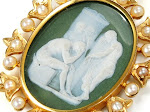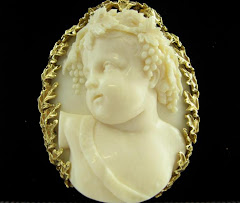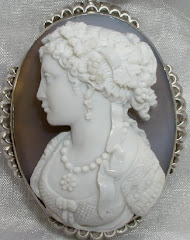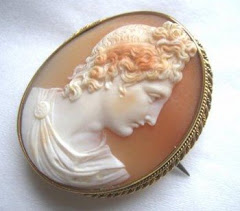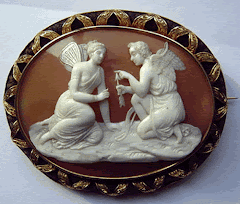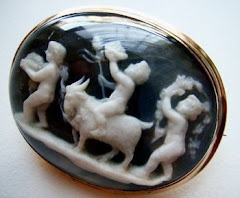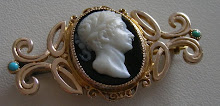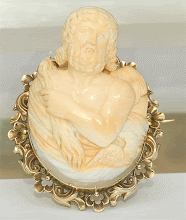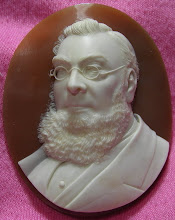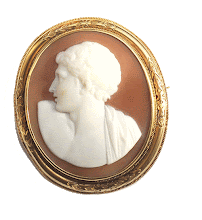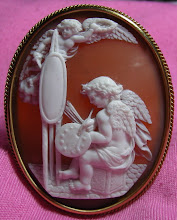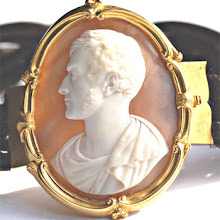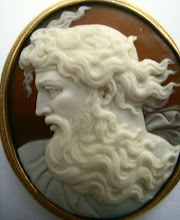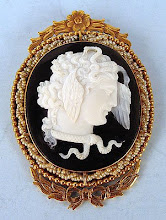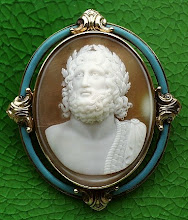My interest in cameos began about 10 years ago when I discovered the website of a cameo dealer in Brescia, Italy. Most of the finest pieces that you will see on my blog site were purchased from his shop. I don't recall how I stumbled upon his website, but I remember thinking that I had never seen anything like the cameos he had on display there. I was fascinated by the mythological subjects, and the quality of the carvings was simply astonishing to me. "Miniature sculptures in shell," I thought. After purchasing a very small cameo of goddess Aurora in a chariot, I began doing research on the genre, and my explorations eventually led me to the website of another very knowledgeable dealer in London from whom I have subsequently purchased many pieces.
Cameos have been around for a long, long time. Particularly fine specimens, carved mostly from various types of agate, were prized by royalty and worn by emperors, including Napoleon. In the nineteenth century, the shell cameo became quite popular with British tourists who often returned to England with a cameo memento of their trip to the excavations at Pompey and other ancient sites. The so-called "Grand Tour" was responsible for the proliferation of cameos carved from shell, lava composites from Mt. Vesuvius, and even coral. Back home, the cameos were often framed so that they could be worn as jewelry. Many were mounted in plain and ordinary frames so as not to detract from the beauty of the carvings themselves. Sometimes, however, the frames were quite elaborate, even exceeding the carvings in terms of sheer beauty. I am particularly fond of enamel frames such as the one of Zeus on this blog site. Enamel frames are difficult to find, and they are almost never in pristine condition.
The majority of the cameos in my collection are carved from shell; it is still my favorite medium. I do own several agate pieces and a few carved from lava, coral, and ivory. Agate cameos are much harder to carve than shell, and for that reason they are more valuable. These days it is very difficult to find first-rate pieces in pristine condition regardless of the medium. When you consider the fact that the older pieces were generally carved between 1850-1870, when the cameo industry reached its peak, it is a wonder that they survived at all.
Most of the cameos from this period are either unsigned or scratch signed with the carver's initials on the back of the shell. The very best gem engravers of the nineteenth century began signing their pieces after Anton Pichler (1697-1779) introduced the custom in order to prevent unscrupulous individuals from selling his cameos as genuine antiquities. Of the cameo carvers who routinely signed their cameos, the most well known are Angelo Amastini, Georges Bissinger (Germany), Giuseppe Girometti, Nicolo Morelli, Benedetto Pistrucci, and the father and son team of Tommaso and Luigi Saulini. The Saulini's exhibited cameos at the Great Exhibitions of London in 1851 and 1862, and in 1856 Queen Victoria commissioned their work. Many portrait cameos from the Saulini workshop in Rome were also commissioned by members of the British aristocracy. I have two in my collection. Benedetto Pistrucci (1784-1855) was so well regarded that he became the Chief Engraver to the Royal Mint in London in 1814. A few years ago the Metropolitan Museum in New York City launched a cameo exhibit in which one of his cameos, an incredible medusa, was displayed. I believe the cameo's owners donated the piece to the Museum. Angelo Amastini produced many wonderful cameos of children. I am fortunate to have one in my collection. Nicolo Morelli's cameos were commissioned by Napoleon. I own a ring with one of his carvings of Apollo.
Most of the cameos in my collection reflect the world of mythology. Mythological subjects were extremely popular. They include Zeus and Hera, the king and queen of Olympus, Hermes (messenger god) and Hebes (cupbearer to the gods), among others. Of all the cameos that I have come across in the last ten years, the most common subject is that of Hebes, the goddess of youth, feeding nectar to Zeus, who appears in the guise of an eagle. I must say, I have yet to encounter a cameo of this subject that made much of an impression on me. Other subjects include (1) cosmological figures such as Eos (goddess of the dawn), Nyx (goddess of night), Selene (the moon goddess), and Phoebus Apollo (sun god); (2) mythical figures of love and passion such as Eros (god of love), Aphrodite (goddess of love), Clytia (a nymph), and Flora (goddess of flowers); (3) mythical figures associated with the arts such as Apollo and the Charites or Three Graces; (4) deities associated with the seasons, fertility, and harvests such as Dionysus or Bacchus (god of wine), Demeter (goddess of agriculture), Pan (god of nature), centaurs, satyrs, wood nymphs, and grylli (grotesque figures). Many cameo figures reflect the story of the Trojan War, and these include Achilles and Hector (Prince of Troy), Paris (son of King Priam of Troy), Menelaos (King of Sparta), and Ajax (Greek warrior). Among the gods and goddesses of hunting and war, the most popular cameo subjects were Athena or Minerva (goddess of war and wisdom), Ares or Mars (god of war), Nike (goddess of victory), Artemis or Diana (goddess of hunting), and Hercules. Lastly, portrait cameos were quite popular among British royals who often sent photographs of themselves to Italian gem engravers to assist them with the carvings. Historical figures such as Mary, Queen of Scots, Shakespeare, and Dante Alighieri, were also in demand.
An excellent source of information about cameos is Michele Rowan's "Nineteenth-Century Cameos" (Antique Collectors' Club, Ltd., 2004). Some of the cameos in my collection are featured in her book.
Subscribe to:
Posts (Atom)

